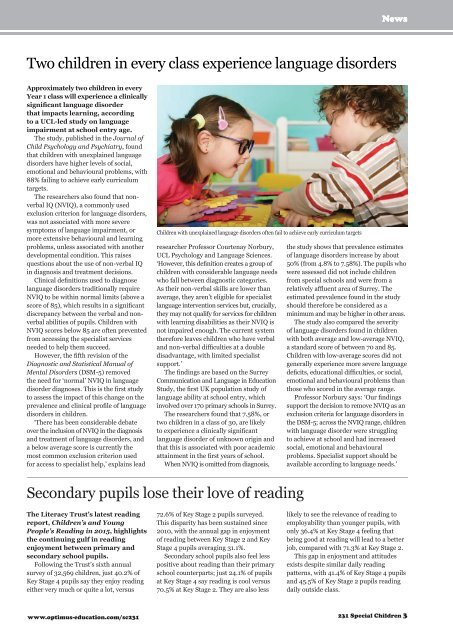champions
1H1C301qFr9
1H1C301qFr9
Create successful ePaper yourself
Turn your PDF publications into a flip-book with our unique Google optimized e-Paper software.
News<br />
Two children in every class experience language disorders<br />
Approximately two children in every<br />
Year 1 class will experience a clinically<br />
significant language disorder<br />
that impacts learning, according<br />
to a UCL-led study on language<br />
impairment at school entry age.<br />
The study, published in the Journal of<br />
Child Psychology and Psychiatry, found<br />
that children with unexplained language<br />
disorders have higher levels of social,<br />
emotional and behavioural problems, with<br />
88% failing to achieve early curriculum<br />
targets.<br />
The researchers also found that nonverbal<br />
IQ (NVIQ), a commonly used<br />
exclusion criterion for language disorders,<br />
was not associated with more severe<br />
symptoms of language impairment, or<br />
more extensive behavioural and learning<br />
problems, unless associated with another<br />
developmental condition. This raises<br />
questions about the use of non-verbal IQ<br />
in diagnosis and treatment decisions.<br />
Clinical definitions used to diagnose<br />
language disorders traditionally require<br />
NVIQ to be within normal limits (above a<br />
score of 85), which results in a significant<br />
discrepancy between the verbal and nonverbal<br />
abilities of pupils. Children with<br />
NVIQ scores below 85 are often prevented<br />
from accessing the specialist services<br />
needed to help them succeed.<br />
However, the fifth revision of the<br />
Diagnostic and Statistical Manual of<br />
Mental Disorders (DSM-5) removed<br />
the need for ‘normal’ NVIQ in language<br />
disorder diagnoses. This is the first study<br />
to assess the impact of this change on the<br />
prevalence and clinical profile of language<br />
disorders in children.<br />
‘There has been considerable debate<br />
over the inclusion of NVIQ in the diagnosis<br />
and treatment of language disorders, and<br />
a below average score is currently the<br />
most common exclusion criterion used<br />
for access to specialist help,’ explains lead<br />
Children with unexplained language disorders often fail to achieve early curriculum targets<br />
researcher Professor Courtenay Norbury,<br />
UCL Psychology and Language Sciences.<br />
‘However, this definition creates a group of<br />
children with considerable language needs<br />
who fall between diagnostic categories.<br />
As their non-verbal skills are lower than<br />
average, they aren’t eligible for specialist<br />
language intervention services but, crucially,<br />
they may not qualify for services for children<br />
with learning disabilities as their NVIQ is<br />
not impaired enough. The current system<br />
therefore leaves children who have verbal<br />
and non-verbal difficulties at a double<br />
disadvantage, with limited specialist<br />
support.’<br />
The findings are based on the Surrey<br />
Communication and Language in Education<br />
Study, the first UK population study of<br />
language ability at school entry, which<br />
involved over 170 primary schools in Surrey.<br />
The researchers found that 7.58%, or<br />
two children in a class of 30, are likely<br />
to experience a clinically significant<br />
language disorder of unknown origin and<br />
that this is associated with poor academic<br />
attainment in the first years of school.<br />
When NVIQ is omitted from diagnosis,<br />
the study shows that prevalence estimates<br />
of language disorders increase by about<br />
50% (from 4.8% to 7.58%). The pupils who<br />
were assessed did not include children<br />
from special schools and were from a<br />
relatively affluent area of Surrey. The<br />
estimated prevalence found in the study<br />
should therefore be considered as a<br />
minimum and may be higher in other areas.<br />
The study also compared the severity<br />
of language disorders found in children<br />
with both average and low-average NVIQ,<br />
a standard score of between 70 and 85.<br />
Children with low-average scores did not<br />
generally experience more severe language<br />
deficits, educational difficulties, or social,<br />
emotional and behavioural problems than<br />
those who scored in the average range.<br />
Professor Norbury says: ‘Our findings<br />
support the decision to remove NVIQ as an<br />
exclusion criteria for language disorders in<br />
the DSM-5; across the NVIQ range, children<br />
with language disorder were struggling<br />
to achieve at school and had increased<br />
social, emotional and behavioural<br />
problems. Specialist support should be<br />
available according to language needs.’<br />
Secondary pupils lose their love of reading<br />
The Literacy Trust’s latest reading<br />
report, Children’s and Young<br />
People’s Reading in 2015, highlights<br />
the continuing gulf in reading<br />
enjoyment between primary and<br />
secondary school pupils.<br />
Following the Trust’s sixth annual<br />
survey of 32,569 children, just 40.2% of<br />
Key Stage 4 pupils say they enjoy reading<br />
either very much or quite a lot, versus<br />
72.6% of Key Stage 2 pupils surveyed.<br />
This disparity has been sustained since<br />
2010, with the annual gap in enjoyment<br />
of reading between Key Stage 2 and Key<br />
Stage 4 pupils averaging 31.1%.<br />
Secondary school pupils also feel less<br />
positive about reading than their primary<br />
school counterparts; just 24.1% of pupils<br />
at Key Stage 4 say reading is cool versus<br />
70.5% at Key Stage 2. They are also less<br />
likely to see the relevance of reading to<br />
employability than younger pupils, with<br />
only 36.4% at Key Stage 4 feeling that<br />
being good at reading will lead to a better<br />
job, compared with 71.3% at Key Stage 2.<br />
This gap in enjoyment and attitudes<br />
exists despite similar daily reading<br />
patterns, with 41.4% of Key Stage 4 pupils<br />
and 45.5% of Key Stage 2 pupils reading<br />
daily outside class.<br />
www.optimus-education.com/sc231<br />
231 Special Children 3


